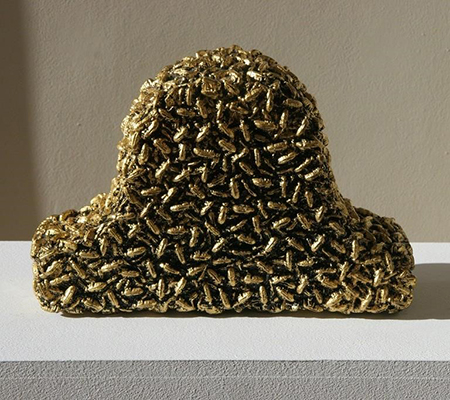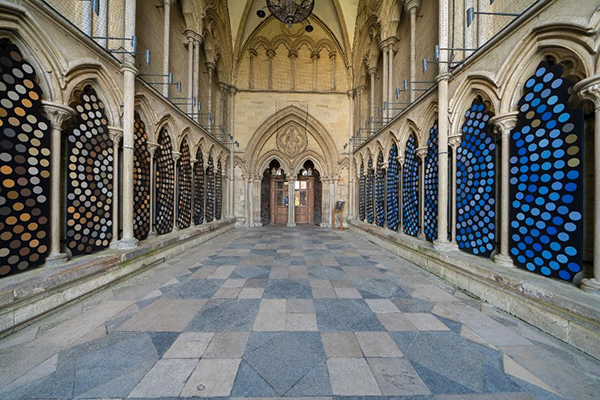It's about time
Our tour of our Cathedral's exhibits continues, with 3 works that focus on our experience of time.
At the moment, our experience of time has been changed significantly by our having to stay as much as possible at home, by the restrictions on our movements, and by our having to rethink how we are to spend our time.
Hirakawa’s 'Candle' is a film related to an impressionistic and emotional experience of time which can work at many levels.
(View it here.)
Laid on its side, the candle burns faster than usual and the melting wax forms a pattern which denotes the ‘leaking’ of time. Before the lockdown we got used to packing more and more into our daily lives, as though we were frightened by a sense of impermanence and vacancy. It may be that by lighting an upright candle at home we can re-orientate parts of our day with a more contemplative experience of time, reflecting on the way we used our time before this crisis.
Woodrow’s 'Clockswarm' also points to the issue of how we use our time. Bees live in an ordered society, they have complex patterns of communication and they produce honey, which gives both them and us energy, and the wax for Hirakawa’s Candle. By depicting a swarm of bees landed on a clock Woodrow suggests an alternative approach to time, something more closely connected to the natural world, its times and seasons.
If we enter the Cathedral by the north porch, we encounter Bruce Munro’s 'Time and Place'. The artist claims that in his work, he is trying to capture those moments when we want to connect with something much larger and greater than our lives. He has also described this Cathedral as an attempt to convey ‘the liminal state, that transition beyond self-awareness.’
This installation in the porch is intended to open a window onto infinite points of light, and to invite us into a place which offers us a glimpse of the beyond. And yet hidden in that glimpse are pixels made up of panoramic photographs of the Cathedral which Munro took this year on his iPhone and then abstracted and recomposed as points of light. That process he says, ‘Correlates to my awareness that my interpretation of experience is perpetually in a state of flux.’ Elsewhere he writes of his experience ‘that time is without boundaries, that the past, present and future were/ are inextricably interlinked.’
At the beginning of the ‘The Four Quartets’, TS Eliot raises a concern about this experience of time:
Time present and time past
Are both perhaps present in time future,
And time future contained in time past,
If all time is eternally present
All time is unredeemable.
It seems that for all 3 of these works in this exhibition, the redeemability of time is a significant question which it is right to ask on the threshold of a Cathedral which has been here for 800 years. What does it mean to redeem time? Our experience of time can vary enormously. Both theology and science tell us that time does not predate the existence of anything. We are not projected into time; time is created with us.
Though we can know time in terms of the hands moving on the clock face, we rarely experience time in that mechanical way. We can waste time. We can ‘take time by the forelock!’ We can never have enough time. Music enables us to experience time both slowly and quickly. Our personal experience of time is often made up of a collection of good and bad memories of the past, and hopes and fears for the future. Our society can be controlled and constrained by group memories and the illusions they may give rise to.
The redemption of time is, in this Cathedral, claimed to be possible through the remembrance of a set of events in 1st century Palestine, and more particularly through the re-enactment of a last supper, and the regular year by year commemoration of the most significant of those ancient events in the Church’s calendar. Each year we explore the meaning of those events, both tragic and joyful, for our lives and the life of our community and society.
How then, finally, are we to use our time? Or, as places of faith constantly ask of us, what are we for? What is the purpose of our life and our use of the time given to us? Can it be described in any meaningful, coherent and even perhaps inspirational way?
One answer to that question might be that we make sense of our lives through story, narratives told across time which we construct for ourselves and for the history of our society. (cf TS Eliot, ‘A people without history is not redeemed from time’). This Cathedral has a complex story to tell across 800 years of time. The builders of this Cathedral would have answered our question about our meaning and purpose in terms of worship, the story of Scripture, especially the story of Jesus Christ, and the love of God and neighbour, which lead us to humanity’s true end - joy and happiness in the glorious vision of God, Father, Son and Holy Spirit.
Document Actions




